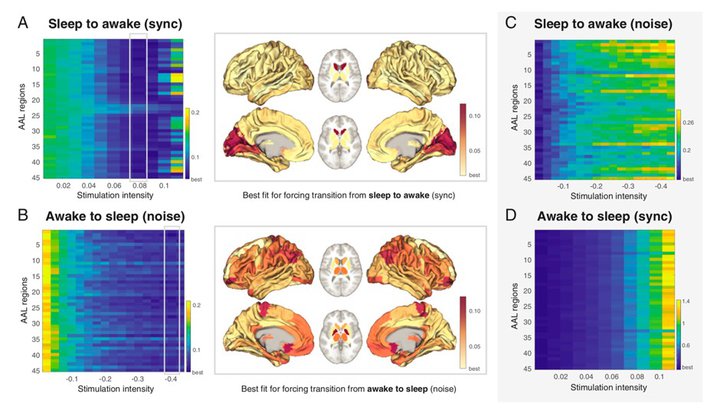New model predicts how targeted stimulation can make the brain change from one state to another
25 September 2019
Using a computational model of the brain, an international group of scientists led by HBP researcher Gustavo Deco of the Pompeu Fabra University in Barcelona and by Morten L. Kringelbach (Ahrus and Oxford universities), have developed an innovative method to improve the precision of brain stimulation.
Using a computational model of the brain, an international group of scientists led by HBP researcher Gustavo Deco of the Pompeu Fabra University in Barcelona and by Morten L. Kringelbach (Ahrus and Oxford universities), have developed an innovative method to improve the precision of brain stimulation. In the Human Brain Project Prof. Deco contributes to the area of Theoretical Neuroscience, where he works on models of brain activity and function. The new results have been published in the Proceedings of the National Academy of Sciences.
 The picture shows the brain areas that when stimulated induce the change from the awake to sleep state, and vice versa
The picture shows the brain areas that when stimulated induce the change from the awake to sleep state, and vice versa
A fundamental problem in neuroscience is how to induce the transition from one brain state to another, for example, from sleep to wakefulness, or to influence pathological brain states in psychiatric diseases and disorders of consciousness. Stimulation methods using weak electric current or magnetic fields provide one potential avenue for these interventions. "It is possible to make the brain transition from one cerebral state to another through external stimulation, but for that it is essential to have a quantitative characterization of the real dynamics ", explain Gustavo Deco and Josephine Cruzat (another member of the team).
Their work provides a quantitative definition that characterizes the different brain states. This information is integrated into a computational model of the human brain. "The underlying dynamics of a brain state were characterized as a set of metastable substates, each with a probability of occurrence and transition between substates. This characterization is then incorporated into a model that simulates brain activity, and is adjusted according to empirical data obtained by functional magnetic resonance," explains Gustavo Deco. The approach serves to allow the systematic study on the effects of brain stimulation in the transition from one brain state to another.
To validate the method, the researchers used data obtained by functional magnetic resonance from healthy subjects both awake and asleep. Once the data had been incorporated into the model, the effects of stimulation on the different brain areas were studied. "Systematic external stimulation in silico made it possible to predict which brain areas, when stimulated, allow the transition from one state to another and vice versa. This is how through the applied current we manage to awaken the sleeping brain," explains Cruzat.
Text adapted with permission from HBP partner UPF Barcelona:
https://www.upf.edu/es/inicio/-/asset_publisher/1fBlrmbP2HNv/content/id/228320739/maximized#.XXZ6ZS4zZaQ
Original Paper:
Gustavo Deco, Josephine Cruzat, Joana Cabral, Enzo Tagliazucchi, Helmut Laufs, Nikos K. Logothetis, and Morten L. Kringelbach (2019), "Awakening: Predicting external stimulation to force transitions between different brain states" , PNAS, Sept 3, https://doi.org/10.1073/pnas.1905534116.
Read further:
Q&A WITH GUSTAVO DECO in the OHBM-Blog:
https://www.ohbmbrainmappingblog.com/blog/qa-with-gustavo-deco-ohbm-2018-keynote-series



